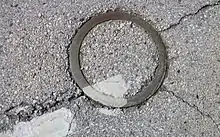Korabl-Sputnik 1
Korabl-Sputnik 1[3] (Russian: Корабль Спутник 1 meaning Vessel Satellite 1), also known as Sputnik 4 in the West,[2] was the first test flight of the Soviet Vostok programme, and the first Vostok spacecraft. It was launched on May 15, 1960. Though Korabl-Sputnik 1 was unmanned, it was a precursor to the first human spaceflight, Vostok 1. Its mass was 4,540 kilograms (10,010 lb), of which 1,477 kilograms (3,256 lb) was instrumentation.[1]
| Mission type | Technology |
|---|---|
| Harvard designation | 1960 Epsilon 3 |
| COSPAR ID | 1960-005A |
| SATCAT no. | 36 |
| Mission duration | 4 days |
| Spacecraft properties | |
| Spacecraft type | Vostok-1P |
| Manufacturer | OKB-1 |
| Launch mass | 4,540 kilograms (10,010 lb)[1] |
| Start of mission | |
| Launch date | 15 May 1960, 00:00:05 UTC |
| Rocket | Vostok-L 8K72 s/n L1-11 |
| Launch site | Baikonur 1/5 |
| End of mission | |
| Disposal | Failed deorbit c. 19 May 1960 |
| Decay date | 5 September 1962[2] |
| Landing site | 44.098951°N 87.657689°W |
| Orbital parameters | |
| Reference system | Geocentric |
| Regime | Low Earth |
| Eccentricity | 0.02879 |
| Perigee altitude | 290 kilometres (160 nmi)[1] |
| Apogee altitude | 675 kilometres (364 nmi) |
| Inclination | 65.02 degrees |
| Period | 94.25 minutes |
| Epoch | 1960-05-15 00:00:00 UTC |
The spacecraft, the first of a series of spacecraft used to investigate the means for manned space flight, contained scientific instruments, a television system, and a self-sustaining biological cabin with a dummy of a man. It was designed to study the operation of the life support system and the stresses of flight. The spacecraft radioed both extensive telemetry and prerecorded voice communications. After four days of flight, the retro rocket was fired and the descent module was separated from its equipment module, but because of an incorrect attitude the spacecraft did not reenter the atmosphere as planned.[2]

The descent module re-entered the atmosphere on September 6, 1962, while the equipment module re-entered on October 15, 1965.[4] A 20-pound piece of the descent module landed in Manitowoc, Wisconsin in the northern United States.[5][6]
Giovanni Battista Judica Cordiglia, who set up his own amateur listening station at Torre Bert near Turin, is reported to have claimed that radio signals were received on November 28, 1960 which could have originated from this spacecraft; the spacecraft is known to have radioed prerecorded voice communications. It has led some to believe a conspiracy theory that the spacecraft may have been manned by the Lost Cosmonauts.[7]
Notes
- "1960-005A (ε1) - Kosmičeskij korabl' 1". Space 40 encyclopedia.
- "Sputnik 4 - NSSDC ID: 1960-005A". NASA.
- McDowell, Jonathan. "Launch Log". Jonathan's Space Page. Retrieved 27 July 2010.
- Hall and Shayer, p.122
- Sputnik Crashed Here, Manitowoc, Wisconsin
- "Sputnik IV Spot Is Marked". Manitowoc Herald-Times. 26 January 1978.
- Interview with Gian Cordiglia
References
- Hall, Rex; Shayler, David (May 18, 2001). The rocket men: Vostok & Voskhod, the first Soviet manned spaceflights. Springer. p. 350. ISBN 1-85233-391-X.
